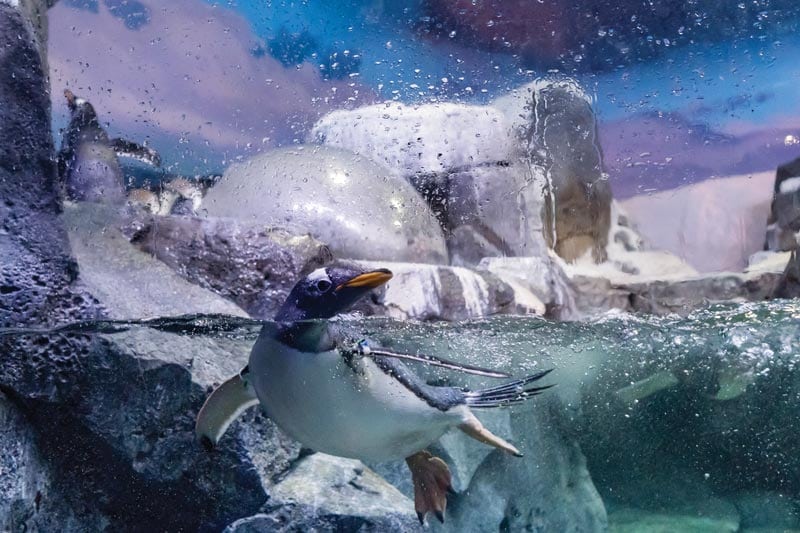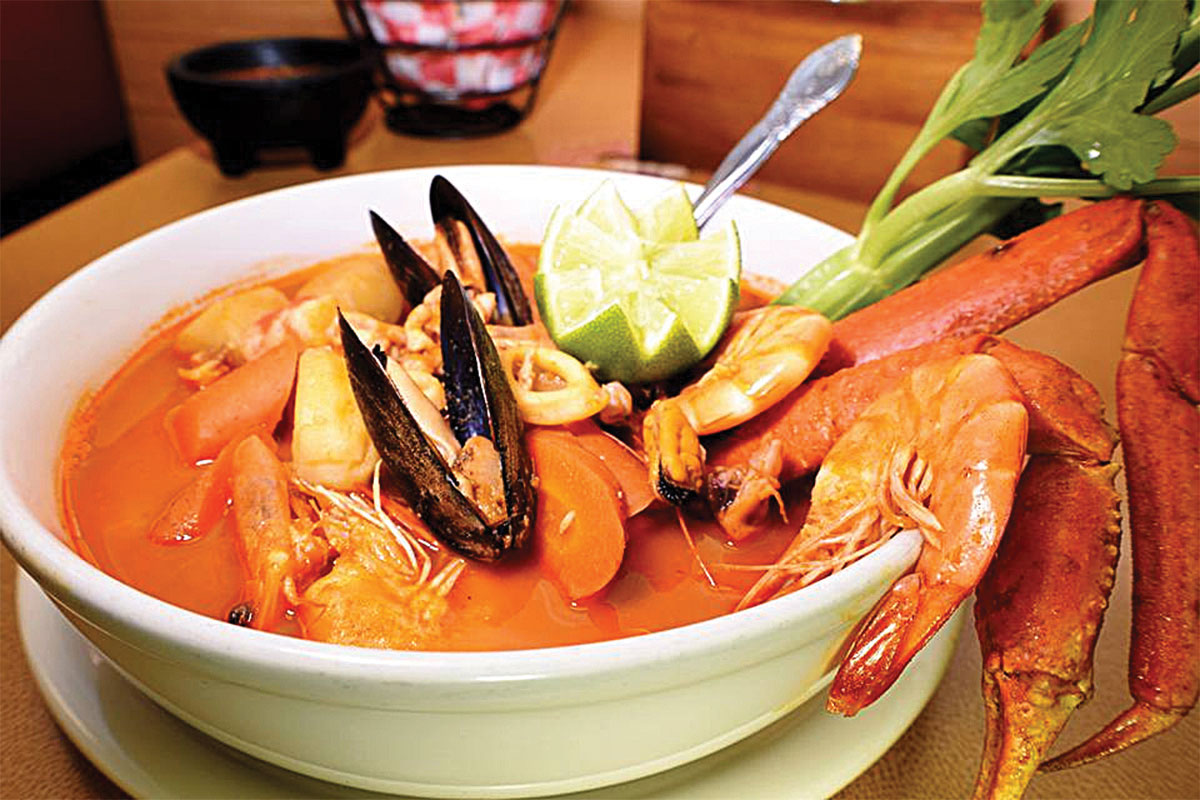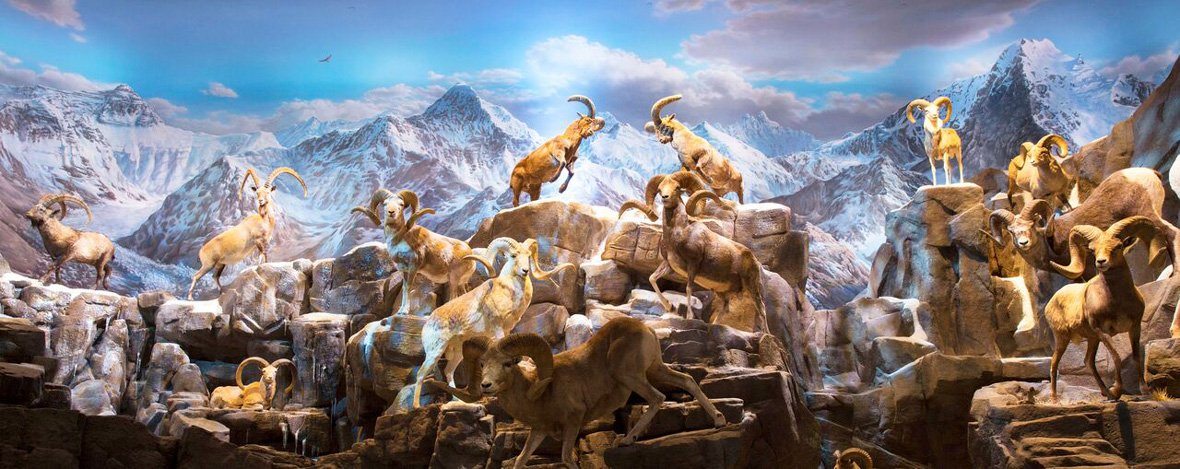Soothing music from a wooden flute wafts through a hall of native artifacts, calling back a forgotten time.
Farther along a winding path, through galleries where visitors hear the roars of lions and the trumpeting of elephants, the dust of an African savanna actually seems to be in the air—which, come to think of it, does feel a little warmer than it did a few yards away, not far from a display of two frozen-in-time Arctic polar bears.
Springfield’s Wonders of Wildlife National Museum and Aquarium “really aims to create an immersive experience for its guests,” says Shelby Stephenson, director of public relations and social media. “We do that through special effects that include changes in sound, changes in lighting, changes in temperature, and even changes in smell effects.”
That sensory experience has been attracting a crowd. With at least 1,000 visitors a day since it opened a year ago, Wonders of Wildlife has drawn people from all parts of Missouri, 49 other states, and several countries.
“We had people who visited from Alaska on opening day and made the trip just to come see it,” Shelby says.

An Expansive Vision
The experience begins as the museum tour commences at the top of an escalator flanked by bison—not live, roaming bison, of course, but authentic likenesses, even at close range.
For Missourians who haven’t stopped by the Bass Pro Shops flagship store in a while, WOW is not the same American National Fish and Wildlife Living Museum and Aquarium they might have seen several years ago. That attraction closed in 2007.
The first museum and aquarium also featured taxidermy and fish, but at one-third the size of the Wonders of Wildlife, it “wasn’t something that people would visit and say to their family and friends back home, ‘You have to see this,’ ” Shelby says.
Yet that kind of tourist destination is just what Bass Pro CEO and Springfield native Johnny Morris had hoped to create, she says—”something people all across the country and all across the world would travel to see and be amazed at what had been created here.”
Over 10 years, the museum’s creation took a $290 million investment and the efforts of more than 2,000—builders, painters, sculptors, woodworkers, iron workers, taxidermists, illustrators, designers, scientists, biologists, and engineers.
It also took the assistance of more than 40 US conservation organizations, including Ducks Unlimited, the National Wild Turkey Federation, the National Park Service, and the National Wildlife Federation. These organizations assisted with interpretive displays and offered live species along with well-preserved specimens.
“A collection like the one we have at WOW certainly doesn’t come together overnight,” Shelby says, “and it’s certainly a labor of love.”
Focus on Conservation
With its taxidermy collections, Wonders of Wildlife might make tourists think of the Field Museum in Chicago or the Smithsonian National Museum of Natural History in Washington, DC.
And displays of 35,000 live fish, as well as reptiles, amphibians, and birds, bring up comparisons to Chicago’s Shedd or California’s Monterey Bay aquariums.
WOW is unique, though, because of “the additional steps we take to transport guests around the world,” Shelby says, and because of its size—larger than even than the Smithsonian’s Museum of Natural History.
Guests take plenty of steps in the three hours it can require to take it all in. Covering 1.5 miles of trails and 350,000 square feet, visitors glimpse wildlife from all seven continents in one form or another.
The adventure begins in North America, in galleries decorated with Native American rugs and overhead fixtures shaped like birch-bark canoes.
Conservation is the focus from the start.
WOW’s first museum galleries chronicle native history, the overhunting that spelled the demise of the American buffalo, and President Theodore Roosevelt’s conservation campaign to save the bison. Exhibits display items such as fish traps, beaded clothing, antique rifles, and Roosevelt’s Rough Riders saddle.
Along the way, as visitors follow “Your Adventure Continues” signs, volunteers bring history to life.
“Teddy Roosevelt loved a rocking chair, and he’d get excited and rock across the room,” says Jerry Nicholson, pointing to a rocker next to a fireplace in a gallery built to resemble Roosevelt’s North Dakota Maltese Cross cabin.
Cathy Nicholson, Jerry’s wife, holds a silken river otter’s pelt as she stands at the entrance to galleries that tell the story of Meriwether Lewis and William Clark’s journey across the West.
“It’s a river otter like they would have seen themselves along the Lewis and Clark Expedition,” Cathy says.
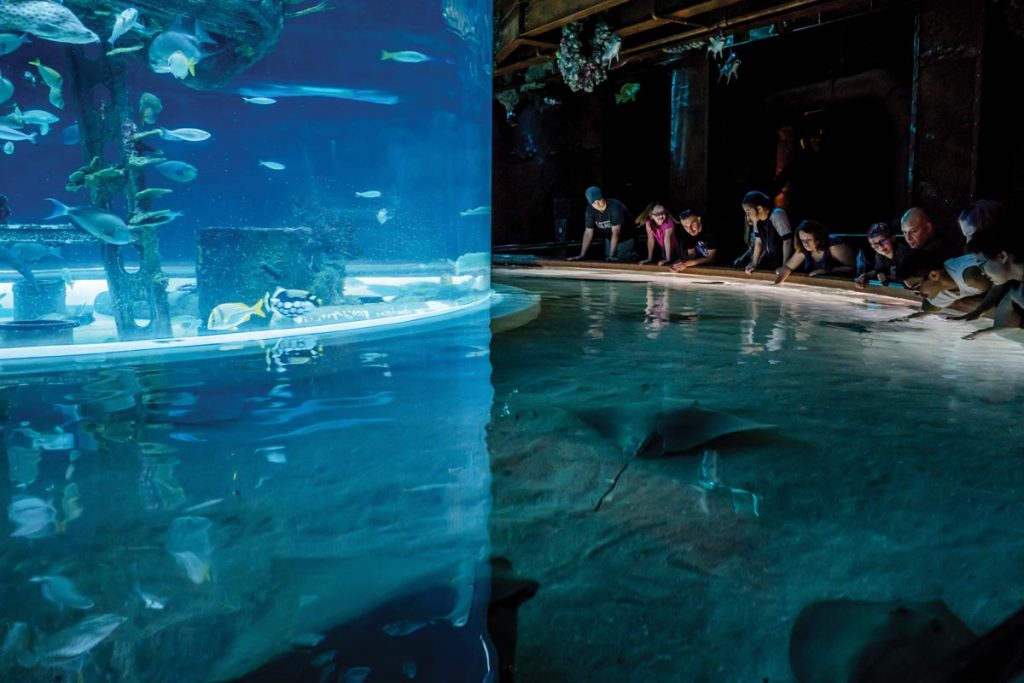
Setting the Scene
The museum showcases art through paintings and photography, as well as diorama murals that spotlight animals large and small, stuffed and alive, in realistic settings.
In the Lewis and Clark galleries, for example, Charles Fritz’s paintings depict the explorers’ adventures.
Murals set the scene for displays from around the globe—the Rocky Mountains for a taxidermy specimen of a mountain lion, Alaska’s Denali National Park as the setting for a formidable grizzly bear, or an Antarctica backdrop for the actual habitat of the live gentoo penguin colony that arrived at WOW last December.
A team of a dozen muralists—many of them Missouri artists—took six years to paint WOW’s murals, which “just really bring the dioramas to life,” Shelby says.
Along with game harvested by modern adventurers like Morris’s son, John Paul—whose 10-foot-6 brown bear from Kodiak Island, Alaska, looms over one diorama—the museum houses famed collections, including the Boone and Crockett Club’s National Collection of Heads and Horns and bighorn sheep hunted by outdoorsman, filmmaker, and philanthropist Arthur Dubs, who died in 2013.
A Himalayan blue sheep from Nepal and a curly horned Marco Polo argali sheep from Tajikistan are among the species harvested by Dubs.
“It’s a breathtaking collection that allows you to understand the diversity of big-game sheep we have all over our planet,” Shelby says.
Live animals reside in the museum, too: last December, WOW adopted a colony of gentoo penguins.
WOW is also home to a few injured and rehabilitated creatures, including Izzy, a green sea turtle from South Carolina that can no longer dive for food or defend herself against predators, and Capella, a bald eagle from Alaska.
“Capella’s wing was broken, so she couldn’t live in the wild,” Shelby says. “Now, she’s on display at WOW for everyone to see.”
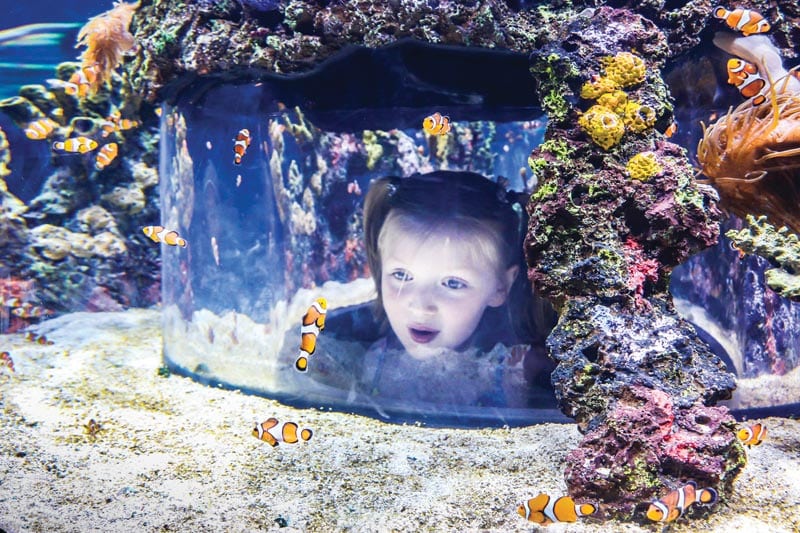
Just For Kids
As 80 freshwater and saltwater aquariums teem with marine life on the other side of their small fingertips, Wonders of Wildlife’s youngest visitors may be the most captive audience there.
On the aquarium side of the attraction, children tunnel into sealed-off “pop-up” domes to look colorful fish in the eye. Dipping hands into a circular petting pool, they brush the smooth backs of gliding stingrays.
As the tour begins, the lighted blue walkways of the Great Oceans Hall lead to the Open Ocean, a large viewing area encircled by a 300,000-gallon aquarium.
There, Jon and Melissa Farley’s four children— Layla, 7; Emma, 6; Jackson, 4; and Mason, 2—rush toward the clear inner walls of the two-story aquarium. From Prattville, Alabama, the Farleys have visited nine national parks so far on their three-week vacation out West.
“They’re awesome,” Layla says as the siblings gaze at fish such as goliath grouper and leopard rays.
“Look at the sharks!” Jackson exclaims, pointing out zebras as they swim past.
From a walkway above, Kayne Meyers stares into a three-story “bait ball” aquarium, transfixed by countless herring as they swirl to fend off another shark—a bonnet-head.
Pointing to the bottom of the tank, where the herring formation isn’t as tight, the 7-yearold from Mountain Grove has some advice for the sharp-toothed predator.
“He should go down there,” Kayne says.
Up Close
Farther along, in Shark Alley, visitors as young as 10 can pay to climb inside a metal diving cage to see even more of brown and sand tiger sharks, along with barracuda, reef fish, and an Atlantic goliath grouper reportedly weighing 400 pounds.
Most kids, though, seem happy to touch horseshoe crabs or pencil urchins in a shallow pool on the other side of that Bahamas-inspired “marina.”
“This is a touch experience,” says volunteer Mary Ellen Campbell. “Nothing here will hurt you.”
“Did you touch the pencil urchin?” Melissa Farley asks Layla, who’s looking at the sea creatures with her sister, Emma. “Want to try?”
“They remember this,” the homeschooling mother adds as the family moves on to a gallery of jellyfish. “They remember it so much more than reading it in a book.”
The Farley children are among thousands who have been getting a hands-on education at WOW since it opened last fall.
Some days, WOW welcomes up to 1,000 schoolchildren on field trips, public relations director Shelby Stephenson says. That’s not counting the Springfield fifth-graders who attend the inquiry-based Wonders of the Ozarks Learning Facility or the area youth who take part in summer camps and programs.
“By exposing these kids and all visitors to the beauty and diversity of our planet, we hope that will inspire them to want to get involved in conservation,” Shelby says.
The petting pool on the main floor is one of the last stops in the multilevel aquarium, and 10-year-old Alyssa Mitchell of Nevada is in no hurry to leave.
Leaning over the shallow pool to touch a stingray, she finally succeeds.
“It felt really hard, like a tip.”
Nature is already one of her places to be, she says, so she likes WOW, even if it means stepping outside her comfort zone.
“It’s very cool, with all the snakes and sharks and stuff,” Alyssa says. “I’m afraid of heights, but going across the alligator pit was fun.”
What: Wonders of Wildlife National Museum and Aquarium
Where: Bass Pro Shops National Headquarters, 500 West Sunshine Street, Springfield
Hours: WOW is open daily. After Labor Day, hours are 10 to 5 Sunday through Thursday and 10 to 8 Friday and Saturday.
Admission: For combo tickets to both the wildlife galleries and aquarium, the cost is $39.95 for adults and $23.95 for children ages 4 to 11. Admission is free for children younger than 4; seniors, military veterans, and the children of military veterans receive discounts.
For more information: Visit WondersOfWildlife.org or call 888-222-6060.
Related Posts
May 3, 1870
On this day the railroad was welcomed into Springfield, Missouri. This effectively removed the Ozarks as a barrier to Springfield's connection with the east.
This Springfield Eatery is Serving Up Authentic Latin American Cuisine
At Leslie’s, customers enjoy an abundance of made-to-order Latin American food for lunch or dinner. Tortas, gorditas, and El Salvadoran papusas stuffed with meat, cheese, and beans are all on the menu.
Wonders of Wildlife by the Numbers
Springfield just got a little wilder. The Wonders of Wildlife National Museum & Aquarium opened on September 21. We’re impressed by the sheer size of this place, so we’ll let the numbers speak for themselves.

